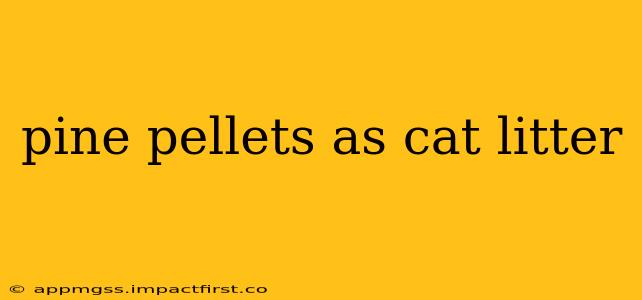Pine pellets have gained popularity as a cat litter alternative, offering a potentially eco-friendly and cost-effective solution for cat owners. However, before making the switch, it's crucial to understand the advantages and disadvantages to determine if it's the right choice for you and your feline friend. This comprehensive guide delves into the details, addressing common questions and concerns.
What are the benefits of using pine pellets for cat litter?
One of the primary benefits of pine pellet litter is its eco-friendliness. Made from recycled wood, it's a biodegradable and renewable resource, unlike many clay-based litters. This reduces the environmental impact associated with litter disposal. Furthermore, pine pellets often boast superior odor control compared to other options. The porous nature of the pellets absorbs and traps odor-causing molecules more effectively, keeping your home smelling fresh. Finally, many cat owners appreciate the cost savings. Pine pellets are typically less expensive than clumping clay litter, potentially saving you money in the long run.
Are pine pellets safe for cats?
This is a crucial question. While many cats tolerate pine pellet litter without issue, it's essential to understand potential risks. Untreated pine pellets can contain phenols, which are aromatic compounds that can be irritating to sensitive cats' respiratory systems and even cause skin irritation. Therefore, it's vital to choose only 100% untreated and dust-free pine pellets specifically designed for pet use. Always check the packaging to ensure it's free from additives or harmful chemicals. If your cat displays any signs of respiratory distress, skin irritation, or changes in behavior after switching to pine pellets, immediately revert to their previous litter and consult your veterinarian.
How do pine pellets compare to other cat litters?
Pine pellet litter stands in contrast to several other options. Clumping clay litter, while widely used, is non-biodegradable and contributes significantly to landfill waste. Silica gel litter, although highly absorbent and effective at odor control, can be expensive. Wheat-based litters are biodegradable but can sometimes be dusty or less effective at odor control. The choice depends on your priorities—cost, environmental impact, odor control, and your cat's individual sensitivities. Pine pellets offer a middle ground, providing a relatively inexpensive, biodegradable option with excellent odor control, provided you choose the right product.
Do pine pellets clump?
No, pine pellets do not clump like clay litter. Instead, they absorb urine and break down into sawdust-like material. This means you'll need to scoop the litter box more frequently than with clumping litter. The frequency depends on the number of cats and their urination habits. However, the complete replacement of the litter is less frequent than with clay litter, as you simply scoop out waste and add fresh pellets as needed.
How much pine pellet litter do I need?
The amount of pine pellets you'll need depends on the size of your litter box and the number of cats. As a general guideline, expect to use significantly more pine pellets than clumping litter over time. It's advisable to start with a larger quantity than you might initially anticipate to ensure you have enough on hand for regular changes.
How often should I change pine pellet cat litter?
The frequency of litter changes depends on how many cats you have and how much they use the litter box. For a single cat, a full change every 2-3 weeks may suffice, or more frequent partial scooping to remove solid waste. With multiple cats, more frequent changes may be necessary. Monitor the litter box regularly and change the litter when it becomes excessively soiled or smelly.
Are there any alternatives to pine pellet cat litter?
Yes, there are several other eco-friendly alternatives to pine pellets, including:
- Recycled paper litter: Made from recycled paper, it is biodegradable and often dust-free.
- Wheat or corn-based litters: Biodegradable and typically unscented.
- Wood pulp litter: Highly absorbent and effective for odor control.
Ultimately, the best cat litter for your needs depends on your priorities and your cat's preferences. Consider the pros and cons of each option before making a decision. Remember to always prioritize your cat's health and well-being.
